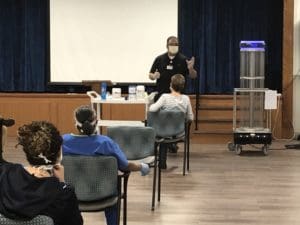The Importance of Language Inclusivity throughout Senior Care

The ability to communicate is one of the most important aspects of life. This is true for people of any age. Yet, having your needs and wishes consistently heard by those around us is a critical part of life that is often taken for granted. Although not typically a worry for the 78.7% of the Rochester population that speak strictly English according to World Population Review, what does that mean for the other 21.3%?
Communication can become a barrier in all aspects of life—from work, to shopping, and even within minor interactions like ordering a pizza on a Friday night. Everything is laced with an added level of difficulty if there are language barriers. St. John’s understands the frustration that can stem from communication challenges and has taken the necessary steps to embrace all cultures by employing additional language inclusivity measures throughout our communities.
To anticipate the communication needs of our residents, one of our most useful long-standing resources at St. John’s is our staff interpreter list. The list features over 30 staff members fluent in 9 different languages and is constantly being updated. These staff members can be called upon to help properly communicate with a resident, which in turn makes that resident feel more at ease and at home.
One staff member on this list is St. John’s Director of Environmental Services Angel Santiago. Angel was raised in a bilingual household with a mother who spoke both English and Spanish and a father who mainly spoke Spanish. He frequently switched between the two depending on his audience to make those around him most comfortable—a useful skill he has carried into his career at St. John’s.
Angel has been at St. John’s for 5 years now and has been invaluable with native Spanish-speakers throughout the St. John’s communities. Even the smallest interactions have proven to make a lasting impression. Angel says that something as simple as a resident transport he did recently at St. John’s Home has “ended in a lasting friendship.”
He preaches the importance of residents being heard and understood. Going above and beyond a simple translation is what sets our employee interpreters apart. Angel takes the time to get to know the resident as opposed to treating it as a language transaction in order to ensure they are comfortable with him first.
“We take about 5 minutes to find out where each other is from, what my parent’s names are, how long I have lived here, how many kids I have, what I like about the States versus my country,” says Angel. This helps to form that initial bond. In response to his kind approach, there is an immediate mood change. A resident who may have started the interaction feeling frustrated often leaves with a smile on their face, feeling relieved that they have formed a connection with someone where they can speak their native language comfortably – even just to chat.
Angel has formed countless resident connections in his time at St. John’s, from bonding over a discussion of Pasteles over the holidays with a St. John’s Meadows resident to bringing back traditional Spanish phrases of respect such as, “bendicion (blessing),”—residents eyes light up. “We often stop and catch up on family and kids which lifts them up and brings them joy,” says Angel. “I love it because it makes me feel proud of my culture.”
Although our interpreter list has been extremely beneficial over the years, this is not our only option when it comes to helping non-English speaking residents communicate. For languages not spoken by staff at this time, we work with various outside interpreter services to ensure all residents, no matter their preferred languages, are comfortable.
In addition to interpreters, our newly implemented Soundmind technology is also helpful for quick communication between staff and the residents at St. John’s Home. The voice recognition technology allows employees or residents the ability to translate to one another with ease.
At St. John’s, celebrating the unique languages and cultures of our residents and staff that make up our communities is just one of the many ways we embrace living.
